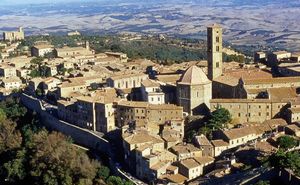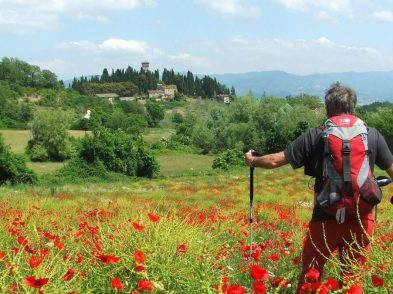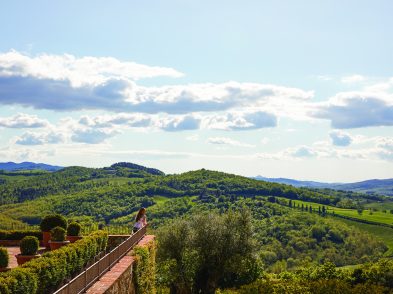“I will tell you what our stay is like. Very well, as far as board and lodging is concerned; what disturbs me a bit is the noise. We live in Via Ferdinanda, also known as Via Grande”. These words were written on August 15, 1827 by Alessandro Manzoni, one of the most famous and internationally acclaimed Italian novelists and author of “The Betrothed”, to describe his stay in Livorno.
A native of Milan and visitor to Venice and Paris he depicted it as a lively, busy city, teeming with people from different nations. He said about Via Grande, the main street, that if you imagine a wild carnival atmosphere, you will only have half of the picture of what was going on there; such is the crowd, the hustle and bustle, the shouting.
The backyard was not quiet either. There was a Greek café, the first in Livorno, whose patrons came from different countries, and read, talked and shouted until late at night.
The funny thing is that the noise also came from the upstairs apartment. Manzoni said that there were some people upstairs, he did not know who, that did something at night, he did not know what. Pietro, a friend of the novelist, assumed, and Manzoni thought he was not far from the truth, that they played a strange and unusual game jumping from one chair to another some thirty feet apart. “And winning this game must give both glory and pleasure judging from the noise they make”.
Livorno is on the coast, less than 100 kilometres from Florence, and is still as vibrant and lively a city as in Manzoni’s days. It is one of the largest ports in the Mediterranean Sea for goods and passengers alike and has many tourist attractions.
Its origins date back to the first millennium BC when the Etruscans settled in the surrounding area, but it was not until the Middle Ages, when the Port of Pise silted up, that Livorno developed from a small village into a town. In 1284, Genoa defeated Pise in the battle of Meloria and came into possession of Livorno which was sold in 1421 to Florence for 100.000 florins.
In 1518, Cardinal Giulio de’ Medici, who later became pope, decided to build an impregnable fortress in Livorno for 5.000 soldiers. The fortress was called Fortezza Vecchia to differentiate it from Fortezza Nuova whose first stone was laid under Ferdinando I de’ Medici. The two fortresses are still standing and open to visitors.
In 1542, Cosimo I de’ Medici ordered the building of a canal to connect Livorno to Pise and, through the Arno River, to Florence. Amazingly, the canal, known as “Canale dei Navicelli”, still exists.
Between 1591 and 1593 Ferdinando I de’ Medici passed a series of laws, known as “Leggi Livornine”, which were to become a milestone in Livorno’s history. Under those laws, designed to populate the city, criminals who moved to Livorno were granted a pardon, while foreigners persecuted because of their race, religion or political orientation were offered a safe haven. A cosmopolitan, tolerant, culturally diversified city was born. The large presence in Livorno of places of worship and cemeteries built by different religious and ethnic groups is testimony to the huge, heterogeneous influx of people who arrived after those laws were passed.
Besides the fortresses and aforementioned places of worship, Venice is another place you should not miss when visiting Livorno. Venice is a small but fascinating replica of the famous city and an integral part of Livorno. Built in the 17th century, under Ferdinando II de’ Medici, in order to connect, through an intricate network of canals, the docks to the warehouses of the numerous merchants operating there and originally called New Venice, it is a district full of charming corners, picturesque bridges and elegant buildings where rich merchants once lived.
An exciting festival, called “Effetto Venezia”, is held in this district each summer, featuring theatre representations, concerts, art exhibitions, street performances, open-air markets, restaurants and cafés.
Livorno boasts one of Italy’s most beautiful theatres; the recently renovated Teatro Goldoni, as well as an interesting aquarium and several museums. Most notably the Natural History Museum, which includes a botanical garden, the Museo Mascagnano, where manuscripts, music scores and paintings of Pietro Mascagni, the famous composer and author of “La Cavalleria Rusticana”, are on display and the Museo Fattori, where you can find temporary, themed art exhibitions and a permanent exhibition of Giovanni Fattori’s works. He was one of the most prominent Italian painters of the 19th century and leader of the Macchiaioli movement.
Livorno’s most famous monument, which is also an emblem of the city, lies near the entrance to the Porto Mediceo and consists of a marble statue of Ferdinando I de’ Medici with four bronze chained figures at his feet, symbolizing his triumph over the pirates who infested the Mediterranean Sea.
For more information about Livorno, check out Mondadori’s “Livorno City Book” which is published in several languages including English.
And, please, do not let Manzoni’s words put you off: Livorno is not that noisy.





